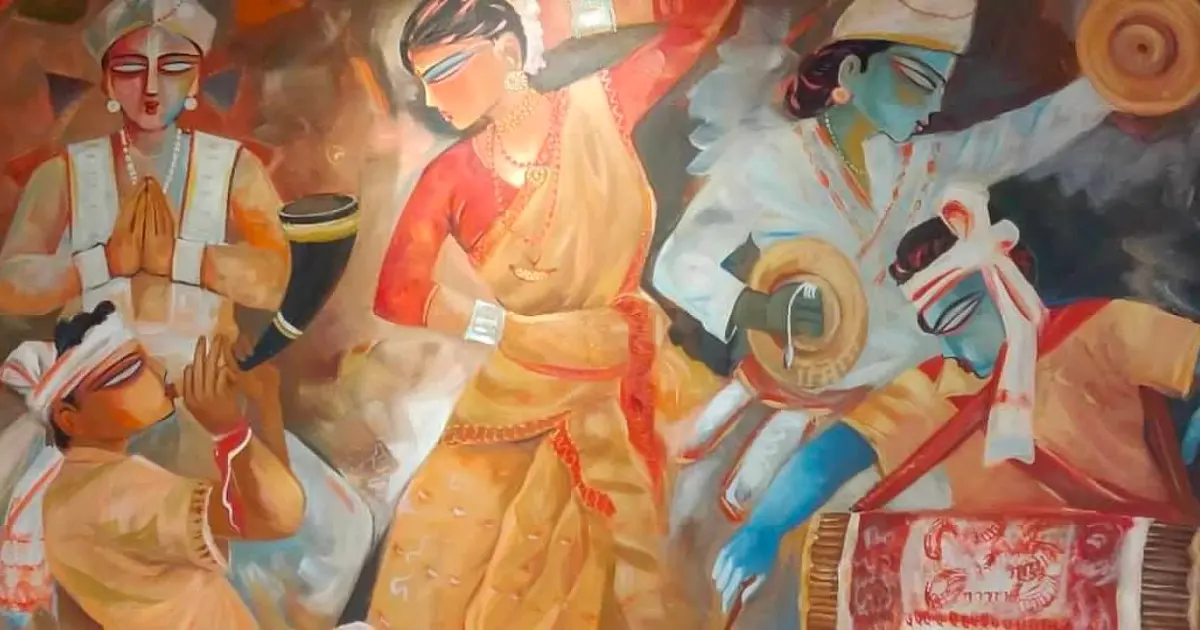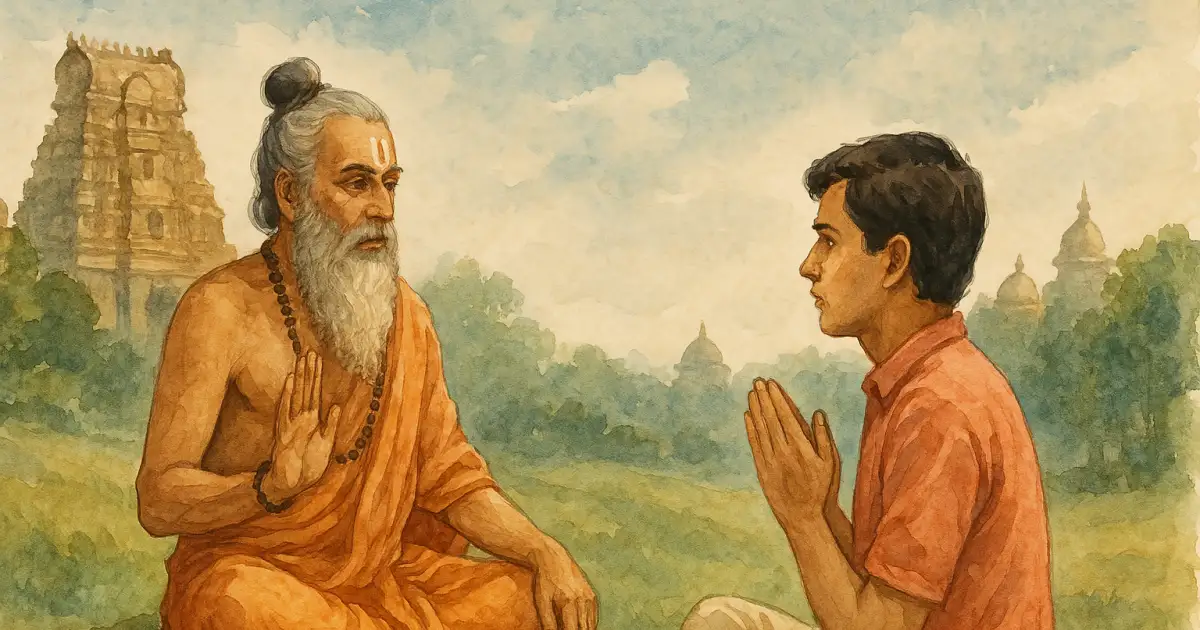Tithi
Karvā Cauth falls on the kṛṣṇa caturthī tithi of the Kārttika month, which is the fourth day (of the dark fortnight) of the month, according to the Hindu pañcāṅga.
The Karvā Cauth fast is traditionally celebrated in the states of Delhi, Haryana, Rajasthan, Punjab, Jammu, Madhya Pradesh, Uttar Pradesh, and Himachal Pradesh.
Scriptural Basis and Prescribed Rituals:
According to the scriptures, Karvā Cauth is mentioned as Karaka (water bowl/vessel) Caturthī (fourth day).
Nārada Purāṇa: Pūrva Bhāga Caturtha Pāda, Chapter 113 (Vratas to be observed on caturthī tithi):
43b–44 The holy rite called Karaka Vrata is to be performed on the caturthī day in the dark half of the month of Kārttika. Only women are authorized to perform this vrata. The rules of the procedure are mentioned below.
44b–45 The woman should take her bath and bedeck herself. She should then worship Gaṇeśa. Ten bowls (karaka) filled with cooked rice shall be kept and dedicated to the Lord of the devas with devotion and a pure mind.
46–47 She should pray: "May the deity be gracious unto me." Saying this, she should dedicate them to God Gaṇeśa. She should give presents respectfully to suvāsinīs (married women) and the brāhmaṇas according to desire. Then at night, when the moon rises, she should duly offer arghya (water oblation) and partake of sweetmeats and cooked rice for the fulfilment of the vrata.
48 Or, the bowls may be filled with milk or water along with rice, betel nut, jewels, and gifted to a brāhmaṇa.
49–51 She should perform this holy rite for sixteen or twelve years. She can also observe it throughout her life. After making the due presents, she should ritualistically conclude this vrata. There is no other vrata like this that yields conjugal blessedness to women. Hence, it should be continuously performed.
Śiva Purāṇa: Chapter 18, Birth of Gaṇeśa on the Caturthī Tithi
Śiva said:
35–37. O Gaṇeśa, you are born in the first prahara on the fourth day in the dark half of the Bhādra month at the auspicious hour of the moonrise. Since your form manifested itself from the good mind of Pārvatī, your excellent vrata shall be performed on that tithi itself or beginning from that day. It will be very auspicious and conducive to the achievement of all siddhis.
38. At the bidding of us both (Śiva & Pārvatī), the vrata shall be performed till the fourth day at the end of a year.
39. Let those who yearn for unequalled happiness in the world worship you devoutly in various ways on the fourth day in accordance with the rules.
46. After worshipping you with various articles of worship like betel, etc., and eulogizing you with hymns, the devotee shall worship the crescent moon.
47. Afterwards, he shall feed the brāhmaṇas joyously with sweets with due honor. He shall take sweets and avoid salt.
48. Then the rites shall formally be dismissed. Then he shall remember Gaṇeśa. Thus, the vrata shall be concluded auspiciously.
49. When the vrata is duly completed in a year, the devotee shall perform the rite of formal dismissal for the completion of the vrata.
50. At my bidding, twelve brāhmaṇas shall be fed. After placing a jar, your image shall be worshipped.
52. Two women and two students shall be worshipped and fed in front of the mūrti duly.
54. The benediction as well as good wishes shall be received. To complete the vrata, handfuls of flowers shall be offered.
55. After prostrations, various routines shall be carried on. He who performs vratas like this can secure the desired fruits.
56. O Gaṇeśa, he who performs your worship up to his ability, with faith, shall derive the fruit of all desires.
57. The devotee shall worship you, the Lord of gaṇas, with vermillion, sandal paste, raw rice grains, and kētakī flowers as well as with other services.
58. Those who devoutly worship you with acts of service will achieve success. Their obstacles will be quelled.
59. These vratas shall be performed by everyone, particularly by women as well as kings, aiming to be prosperous and flourishing.
66. When Gaṇeśa was installed, the whole universe attained peace and normalcy. There was great jubilation. All miseries ended.
67. O Nārada, Pārvatī and Śiva rejoiced in particular. Plentiful auspiciousness led to happiness everywhere.
68-69. The devas and the ṛṣis, who had come there, returned at the bidding of Śiva, praising Pārvatī and Gaṇeśa again and again, eulogizing Śiva.
74. Thus requested by you, I have narrated the glorious story of Pārvatī and Śiva, along with that of Gaṇeśa, with great reverence.
75. Whoever hears this narrative auspiciously with a pure mind shall have everything auspicious and be the abode of auspiciousness.
76. The childless will get a son, the indigent wealth; the seeker of a wife will get a wife, and the seeker of issues will get children.
77. The sick will regain health; the miserable will have good fortune. The sonless, impoverished, banished wife will be reunited with her husband.
78-79. The sorrowing will be relieved of sorrow, undoubtedly. The house that contains this story shall certainly be auspicious. He who listens to this narrative at the time of travel or on holy occasions, with a pure mind, shall get all desires, thanks to the grace of Lord Gaṇeśa.
Underlying Theme
From the above-mentioned scriptural references, we see the common link of the divine feminine/wife/mother (Devī Pārvatī), the importance of the masculine/husband/father (Lord Śiva) as well as the child, Lord Gaṇeśa, and his association with the caturthī tithi, especially in the Bhādrapada month (birthday) and then in the holy month of Kārttika, and that it should be continued throughout the year for infinite blessings of Lord Śiva, Pārvatī, and Gaṇeśa, as per the Śiva Purāṇa.
The cultural underpinnings of this particular vrata are evident throughout the scriptural references, as it reflects the values, beliefs, and social norms like family, etc.
Story Recited During the Karvā Cauth Vrata
There was a beautiful princess named Vīravatī. She was an ardent devotee of Goddess Pārvatī. She had seven loving brothers. The princess decided to spend the first Karvā Cauth at her maternal home. She observed a strict fast from sunrise, and by evening, she was extremely fatigued due to her frail and delicate constitution.
Her brothers were troubled by this and decided to set up a fake moon to make her end her fast. Under this trick, she broke her fast and ate. Immediately, she received the news of her husband’s death and rushed to her matrimonial home. On the way, the princess prayed to Goddess Pārvatī, who then appeared before her along with Lord Śiva and informed her of the reason for her husband’s death.
Upon her pleading for forgiveness, Goddess Pārvatī granted her a boon to revive her husband.
Princess Vīravatī returned and saw her husband alive but in a comatose state, with hundreds of needles inserted into his body. She removed one needle every day until only the last one remained on Karvā Cauth the next year. Upon removal of that final needle, her husband woke up, and she reunited with him.
The Story of Karvā Cauth: A Tale of Love, Loss, and Faith
Long ago, there lived a devoted woman named Karvā. She had seven brothers who adored her deeply. One year, during a visit to her parental home, Karvā chose to observe Nirjala Vrata—a fast without food or even water—praying for her husband's long life.
As the day wore on, the strain of fasting began to take its toll. Weakened by hunger and thirst, Karvā grew pale and eventually fainted. Her brothers, heartbroken to see her in such distress, begged her to break her fast. But Karvā was firm. She would wait for the moon to rise, as the tradition demanded.
Unable to watch her suffer any longer, the brothers hatched a plan. Climbing a pippala tree, they lit a flame behind a sieve and made it appear as though the moon had risen. Seeing what she believed was moonlight, Karvā performed the ritual and ended her fast.
But what seemed like a relief turned tragic. Her husband, the reason for her fast, suddenly fell gravely ill and died. The deception, though well-intentioned, had broken the sanctity of the vow.
Devastated, Karvā wept inconsolably. Her prayers, however, did not go unheard. Goddess Indrāṇī, the wife of Lord Indra, appeared before her. She comforted Karvā and told her to keep the fast again—not just once, but every month—with full devotion and sincerity. If she remained true to her vow, her husband’s life could be restored.
Karvā followed the advice with unwavering faith, observing the fast month after month. Her persistence was rewarded: her husband was brought back to life.
Vrata Utsava Candrikā 8.1
As per this reference, there is a mention of Draupadī performing the Karvā Cauth Vrata when Arjuna advanced to the Nīl-giri mountain for austere penance before the Mahābhārata war. Draupadī prayed to Lord Kṛṣṇa, and he advised her to observe the Karvā Cauth fast based on the story of Vīravatī (daughter of Ved Śarmā and Līlāvatī of Indraprastha), told by Lord Śiva to Goddess Pārvatī. This eventually helped the Pāṇḍavas win the war.
Modern-day Rituals of the Festival
On Karvā Cauth day:
- Ladies wake up early in the morning and perform ritual baths.
- Karvā (pot) pūjā is performed for Lord Gaṇeśa, Śiva, Gaurī (Pārvatī), and Lord Kārttika (Kārttikeya or Subrahmaṇya) for their family members’ health and wealth.
- Mother-in-law offers special food, sargī, for her daughter-in-law, which is to be consumed before sunrise. In Rajasthan, newlywed brides’ in-laws receive the bāyā from her parents (the evening before) containing sweets, dry fruits, mathri, jewelry, and a sāṛī.
- Full-day fast (till moonrise) and without water.
- A ritual thālī is prepared with the following items: Karvā (pot) with roli tied around it, flour lamp (dīyā), kalaśa, sieve, flowers, rice, vermillion, and sweets.
- In the evening, women adorned in the best of attire, henna, and jewelry gather together in small groups to perform the Karvā Cauth pūjā (a caukī is decorated and Gaur Mātā/Pārvatī is seated) and recite the story of Karvā Cauth while passing around their respective thālīs (pherī) amongst each other.
- An elderly woman of the family narrates the story. Tilaka is applied to Gaur Mātā and then on each lady’s forehead and hair parting. The third finger and thumb of the right hand are used by the women to sprinkle it on the deity thrice, and then rice is also showered.
- After the pūjā, the thālīs of everyone are collected and offered to the eldest female member of the family, and her blessings are received for happiness and wealth.
- Upon moonrise, the ladies are informed by the children and men of the house. The ladies then view the moon through the sieve and offer arghya. Then they view their husband’s face through the same sieve. The husband feeds water and sweets to his wife.
Songs Sung During the Thālī Rounds (Pherīs):
This particular song has seven rounds. The first talks about the rituals during the day. The six pherīs are dedicated to restrictions on this day to be observed by women:
1st–6th Pherīs
Vīro kuṛiye karvāṛā,
Sarva suhāgan Karvāṛā,
Āye kaṭṭī nā terī nā,
Kumbh charakhrā pherī nā (don’t weave),
Gvāṇḍ pair payīṁ nā (visiting friends),
Sūī chā dhāgā payī nā (stitching),
Ruthḍā manīeṁ nā (placating upset ones),
Suthrā jagāīeṁ nā (waking up sleeping ones),
Bahāeṁ pyārī vīrā,
Cān chaḍḍe te pāṇī pīnā,
Lay vīro kuṛiye karvāṛā,
Lay sarva suhaāgan karvāṛā.
Translation:
O dear sister, Karvāṛā has come,
A blessing for all married women.
Do not cut or weave today,
Do not spin the wheel of the potter.
Do not go visiting friends,
Do not stitch with needle and thread.
Do not pacify the upset ones,
Do not wake the sleeping ones.
O beloved brother,
When the moon rises, only then drink water.
Take this Karvāṛā, dear sister,
Take this blessing, O all married women.
7th Pherī (lifting of restrictions):
Vīro kuṛiye karvāṛā,
Sarva suhāgan karvāṛā,
Āye kaṭṭī nayā terī nī,
Kumbh charakhrā pherī bhī,
Gvāṇḍ pair payīṁ bhī,
Sūī chā dhāgā payī bhī,
Ār pair payīṁ bhī,
Ruthḍā manīeṁ bhī,
Suthrā jagāīeṁ bhī,
Bahāeṁ pyārī vīrā,
Cān chaḍḍe te pāṇī pīnā,
Lay vīro kuṛiye karvāṛā,
Lay sarva suhaāgan karvāṛā.
Translation:
O dear sister, Karvāṛā has come,
A blessing for all married women.
Now you may cut and weave,
Now you may spin the wheel.
You may go visiting friends,
You may stitch with needle and thread.
You may walk freely,
You may pacify the upset ones,
You may wake the sleeping ones.
O beloved brother,
When the moon rises, then drink water.
Take this Karvāṛā, dear sister,
Take this blessing, O all married women.
Rajasthani Version:
Women exchange the karvās seven times. Each time they are asked:
“Dhapī kī nī dhapī?”
(धपी की नी धपी? = Are you satiated?)
They respond:
“Jal se dhapī, suhaāg se nā dhapī.”
(जल से धपी, सुहाग से ना धपी = I am satiated by water, but not from the love of my husband.)
Uttar Pradesh Version:
Karvās are exchanged seven times while the elderly woman/women priest sing:
Sadā suhaāgan karve lo,
Pati kī pyārī karve lo,
Sāt bhāiyoṁ ke bahin karve lo,
Vrat karnī karve lo,
Sās kī pyārī karve lo...
Translation:
Accept this karvā, a blessing for lifelong marriage,
Accept this karvā, beloved of your husband,
Accept this karvā, sister of seven brothers,
Accept this karvā, keeper of the vow,
Accept this karvā, beloved of your mother-in-law...
Similar Concept Celebrations Across India (not necessarily on the same day):
i. Vaṭa Sāvitrī Vrata / Sāvitrī Amāvasyā
This festival takes place on the new moon day in the month of Jyeṣṭha, when married women observe a fast to seek the blessings of Devī Sāvitrī for a long and healthy life for their spouse.
Devī Sāvitrī and the banyan tree are worshipped by tying a sacred thread around it. It was under a banyan tree that Sāvitrī held her dead husband and asked Lord Yama for a boon to revive her husband; therefore, it is believed that it was instrumental in showering Sāvitrī with the courage and intelligence to bargain.
In Odisa, the household grinding stone is considered to be a symbolic representation of Sāvitrī, and hence it is worshipped on this day.
ii. Vaṭa Pūrṇimā Vrata
Mainly celebrated by married women in North India and Western India, like Gujarat, Goa, and Maharashtra. Vata Pūrṇimā is celebrated on the full moon of the Jyeṣṭha month (May–June). Women perform this fast for three days, concluding on the pūrṇimā night.
During these three days, women draw pictures of Yama, Satyavān, Sāvitrī, and a banyan tree (vaṭa) on the floor or a wall in the home. The couple’s (Satyavān and Sāvitrī) golden engraving/outline is placed on a wooden caukī, mantras are chanted, five fruits and a coconut are offered. And then a banyan tree is worshipped outdoors, and a thread is tied around the tree’s trunk. An offering of copper coins is also placed. Similar to Karvā Cauth, during the pūjā, women greet each other with "janma Sāvitrī ho" (May we be like Sāvitrī).
iii. Varalakṣmī Vratam
Varalakṣmī Vrata (also known as Varalakṣmī Pūjā) is a day of veneration and prayers unto the Varalakṣmī avatāra of Śrī Lakṣmī. Married women perform this vrata in South India for their saubhāgya as well as that of their husband and family. It occurs on a Friday night before the full moon in the month of Śrāvaṇa (July–August).
People pray to Goddess Lakṣmī with utmost devotion and offer fruits, sweets, and flowers. A kalaśa (representing Lakṣmī) is decorated with a sāṛī and gold jewelry.
iv. Aṭla Taḍḍe
This is celebrated both by married and unmarried women for the long life of the husband and for getting a suitable groom, respectively. It occurs on the third night after the full moon in the Āśvayuja month of the Telugu calendar (September or October). It is the Karvā Cauth of the South, with a kalaśa and prayers offered to Mā Gaurī. Ladies gather together to perform pūjā. The fast is concluded by eating small dosās (aṭlu) after gazing at the moon and taking its blessings.
v. Tiruvātira
This festival is celebrated particularly in Kerala and Tamil Nadu by married and unmarried women, both for the health and happiness of the husband and for getting a suitable groom, respectively.
It occurs on the full moon night in the Mārgaḻi (Dec–Jan) month of the South Indian calendar. The deities are Naṭarāja and Śivakāmasundarī (Pārvatī). According to literary and stone inscriptions, this festival has been celebrated for over 1500 years.
Married women fast for the full day (Tiruvempāvai Noṇbu) and break it after witnessing the moonrise. It is a ten-day fast with the noṇbu (fasting) beginning nine days before the penultimate day, which is the Tiruvāthirai day.
vi. Maṅgala Gaurī Vrata
This is celebrated every Tuesday in the month of Śrāvaṇa by married women for their husbands’ health and wealth, and also by unmarried women for a suitable groom.
vii. Hariyālī Tīj
It is celebrated on the third day of the śukla pakṣa of the Śrāvaṇa month (Jul–Aug). It is a festival for married ladies, and the deities are Śiva–Pārvatī, as it celebrates their union and their marital bond. It is mainly celebrated in North India.
viii. Gaṅgaur (Gaurī Tṛtīyā)
Celebrated mainly in Rajasthan, it is dedicated to mā gaurī (Pārvatī) and her dedication to being in union with Śiva. It is an ode to their bond as husband and wife. This festival spans eighteen days and is celebrated by married and unmarried women for the health and happiness of themselves, their husband, and their families.
Conclusion
The theme of women being referred to as saubhāgyavatī refers to her happiness, which is an amalgamation of prosperity, spouse, children, family, health, and wealth. This is reflected in the above-mentioned festivals where women perform these vratas for getting the blessings of saubhāgya by the Goddesses.
This theme of a devoted wife being the well-being of her spouse and entire family is recurrent in our scriptures—in the story of Devī Anasūyā and her passing on the wisdom to Sītā, and in the Śiva Purāṇa when Devī Pārvatī is advised on patnī-dharma by an elderly, wise lady just before her marriage.
It is a beautiful festival that highlights the importance of women in one’s life in the form of a wife and how her saubhāgya brings health, prosperity, and long life to the husband.
References:
- https://www.wisdomlib.org/definition/karaka
- https://archive.org/details/dli.bengal.10689.12976/page/n110/mode/1up?view=theater
- https://www.wisdomlib.org/hinduism/book/shiva-purana-english/d/doc226138.html
- https://archive.org/details/in.ernet.dli.2015.473582/page/n249/mode/2up?view=theater
- https://indianculture.gov.in/stories/karva-chauth
- https://www.prabhatkhabar.com/religion/vat-savitri-vrat-2024-date-puja-vidhi-shubh-muhurat-upay-pujan-samagri-list-sry
-
https://www.hindu-blog.com/2007/12/significance-of-arudhra-darshan.html
- https://timesofindia.indiatimes.com/religion/rituals-puja/mangala-gauri-vrat-2024-date-puja-rituals-story-and-significance/articleshow/111916728.cms
- https://www.rudraksha-ratna.com/articles/gangaur
- https://spusht.blogspot.com/2013/04/gangaur-pooja-gangaur-festival-of-rajasthan.html
- https://www.wisdomlib.org/hinduism/compilation/puranic-encyclopaedia/d/doc241383.html






